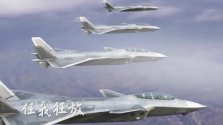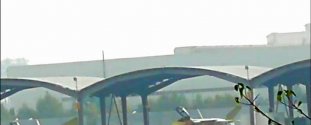You are using an out of date browser. It may not display this or other websites correctly.
You should upgrade or use an alternative browser.
You should upgrade or use an alternative browser.
J-20 5th Generation Fighter VII
- Thread starter siegecrossbow
- Start date
- Status
- Not open for further replies.
Looks very plausible to me.
Pending clearer pictures of course.
Also note the J-20 in the adjacent hangar to the aircraft's right -- that should be a standard single seater J-20, and we can see how its canopy is quite a bit smaller/shorter.
Do we have a sense on missions twin-seater might perform? I've heard MUM-T with UAVS/UCAVs is one option. A second seat should also support an attack role.Looks very plausible to me.
Pending clearer pictures of course.
Also note the J-20 in the adjacent hangar to the aircraft's right -- that should be a standard single seater J-20, and we can see how its canopy is quite a bit smaller/shorter.
Maybe SEAD?Do we have a sense on missions twin-seater might perform? I've heard MUM-T with UAVS/UCAVs is one option. A second seat should also support an attack role.
Do we have a sense on missions twin-seater might perform? I've heard MUM-T with UAVS/UCAVs is one option. A second seat should also support an attack role.
Assuming they keep the same overall airframe (which is the working assumption based on that AVIC frame of a twin seater J-20 from last year), then the primary advantage of having a second seat would be enhanced battle management and enhanced UAV control capabilities relative to a single seater.

The second seat wouldn't really offer much more for the strike role, because a modern multirole aircraft can conduct quite complex strike missions even with one pilot (and especially so for a 5th gen aircraft) and also because the airframe shouldn't have any extra provisions for strike compared to the single seater either.
IMO the battle management mission really cannot be underestimated. Given the way air combat is going in terms of complexity, and given the inherent networking and sensor capabilities of a 5th generation aircraft, having an entire second pilot that is able to dedicate themselves and focus on the battlespace and assist friendly aircraft (and ships and ground forces/air defenses), while having virtually the same level of signature reduction and combat capabilities as a standard J-20, means you have a much more survivable battlespace/networking node that can operate closer to the "front line" and which is more dispersed/distributed in nature, than traditional AEW&C.
And of course, the benefits for controlling UAVs/UCAVs is obvious as well.
A single seater J-20 would likely have those same capabilities assuming their avionics suites are the same -- BUT, the single pilot would be hard pressed to simultaneously carry out its primary air combat mission and conduct the same extent of BM/UAV control missions simultaneously like a twin seater would, OR it would have to fly quite some distance from behind the "front line" to be able to focus on the BM/UAV control mission to the same effectiveness of the second seater in the J-20S.
However you cut it, assuming the avionics and sensor suites in a J-20 single seater and a J-20S twin seater are the same, the "capacity" to perform the BM and UAV control mission under equal combat conditions will be substantially greater in the J-20S simply by virtue of having a second additional human being in the aircraft.
The possibilities are limitless.
Imagine a J-20 controlling a swarm of ELINT drones feeding targeting data to another J-20 with a swarm of LO UCAVs. Those strike drones could be carrying long range air to surface missiles to decapitate air defences; or air to air missiles to shoot down OPFOR high value assets.
The same could be done with ASW/MPA, electronic warfare, comms relay and other drones.
The processing power on board these jets must be immense to enable all this.
Imagine a J-20 controlling a swarm of ELINT drones feeding targeting data to another J-20 with a swarm of LO UCAVs. Those strike drones could be carrying long range air to surface missiles to decapitate air defences; or air to air missiles to shoot down OPFOR high value assets.
The same could be done with ASW/MPA, electronic warfare, comms relay and other drones.
The processing power on board these jets must be immense to enable all this.
I can understand that the j-20 fifth generation machine can not complete complex tasks alone. So a seat was added to supplement it?In other words, the hardware of the J20 can not reach the level of the fifth generation.Assuming they keep the same overall airframe (which is the working assumption based on that AVIC frame of a twin seater J-20 from last year), then the primary advantage of having a second seat would be enhanced battle management and enhanced UAV control capabilities relative to a single seater.
View attachment 78465
The second seat wouldn't really offer much more for the strike role, because a modern multirole aircraft can conduct quite complex strike missions even with one pilot (and especially so for a 5th gen aircraft) and also because the airframe shouldn't have any extra provisions for strike compared to the single seater either.
IMO the battle management mission really cannot be underestimated. Given the way air combat is going in terms of complexity, and given the inherent networking and sensor capabilities of a 5th generation aircraft, having an entire second pilot that is able to dedicate themselves and focus on the battlespace and assist friendly aircraft (and ships and ground forces/air defenses), while having virtually the same level of signature reduction and combat capabilities as a standard J-20, means you have a much more survivable battlespace/networking node that can operate closer to the "front line" and which is more dispersed/distributed in nature, than traditional AEW&C.
And of course, the benefits for controlling UAVs/UCAVs is obvious as well.
A single seater J-20 would likely have those same capabilities assuming their avionics suites are the same -- BUT, the single pilot would be hard pressed to simultaneously carry out its primary air combat mission and conduct the same extent of BM/UAV control missions simultaneously like a twin seater would, OR it would have to fly quite some distance from behind the "front line" to be able to focus on the BM/UAV control mission to the same effectiveness of the second seater in the J-20S.
However you cut it, assuming the avionics and sensor suites in a J-20 single seater and a J-20S twin seater are the same, the "capacity" to perform the BM and UAV control mission under equal combat conditions will be substantially greater in the J-20S simply by virtue of having a second additional human being in the aircraft.
I can understand that the j-20 fifth generation machine can not complete complex tasks alone. So a seat was added to supplement it?In other words, the hardware of the J20 can not reach the level of the fifth generation.
That's not what I wrote.
I said that keeping all else equal, a twin seater J-20S will have far more capable battle management and UAV control capabilities than a standard single seat J-20.
There is no way for us to reverse engineer out how capable the single seat aircraft's inherent avionics suite is based on the existence of a twin seater lol
Having a second seat is almost always better in the BVR age than a single pilot. The issue is that the US struggles to even find enough pilots to fill its current fleet. The US needs to rely on AI whereas China has the man power to provide second seats. There's pros and cons for each option.I can understand that the j-20 fifth generation machine can not complete complex tasks alone. So a seat was added to supplement it?In other words, the hardware of the J20 can not reach the level of the fifth generation.
- Status
- Not open for further replies.


